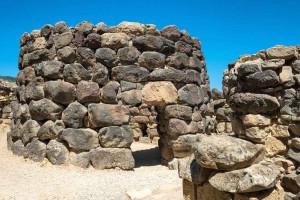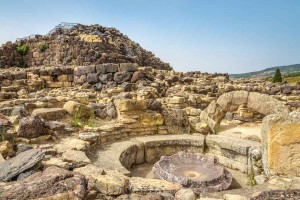
©Bigstock.com/Vakhrushev-Pave
Sardinia’s prehistory left a great variety of marks on the entire island, all of which you absolutely need to explore. It goes back many thousands of years and can be experienced today quite wonderfully in time lapse. Numerous monuments and ruins await you on the coast and in the hinterland. They are supported by special exhibitions in the museum of the island taking you on a journey to days long gone. Among the most important and most spectacular relics of Sardinia’s prehistory are the nuraghes – tower-like constructions that most likely developed during the Bronze Age. The impressive complex Su Nuraxi di Barumini was even named UNESCO World Heritage Site in 1997 and is the destination of our journey today.
Bonnanaro culture and Nuragic civilization
These ancient towers are closely connected to two cultures, both of which played an important role in the formation and development of Sardinia. First, the Bonnanaro culture (2,200 to 1,600 BC) dominated life on the island. It marked the transition from the Copper Age to the early Bronze Age and was predominantly known for its plain ceramics, distinctly influenced by the Polada culture. This era saw the construction of Tomba dei Giganti, precursors of the giants’ tombs, and prototypes of the nuraghes. Traces of the Bonnanaro culture were discovered rather late; excavations of the first necropolises only took place in the late 19th century
The Nuragic civilization tied in directly with the Bonnanaro culture and lasted, depending on the geographic location, even until after the conquest by the Roman Empire. There are no written documents allowing us to precisely retrace the history of the Nuragic civilization, only a few (embellished) notes in classic Greek and Roman literature. While, thus, some aspects of the culture will remain unknown forever, their soft spot for gigantic construction left rather helpful marks. The Nuragic civilization developed the giants’ tombs – such as Muraguada and Madau – even further and fine-tuned the Sardinian rock tombs. Their most important architectural accomplishment, however, gave the culture its name: the impressive nuraghes. They developed even further during the transition to the Iron Age, until Carthaginians and Romans attacked Sardinian cities. The island surrendered after a devastating defeat during the First Punic War around 238 BC and the Nuragic civilization disappeared soon after. It survived a bit longer in the inland until the era of the Roman Empire.
Meaning of the nuraghes
So, the Nuragic civilization leaned towards enormous, colossal constructions. But why were the eponymous nuraghes so important for their society? For starters, it is sadly unknown where the term nuraghe actually comes from. The Romans already used it in the 3rd century BC, but we lost its etymologic meaning. It might have been a Punic word, or a completely new creation based on the words for “pile” or “cave”. Over 7,000 nuraghes have been found to this day. Scientists believe that there might have originally been even more than 10,000.
These constructions made of undressed stone dominate the Sardinian landscape to this very day, yet not much can be said about their exact meaning or purpose. The tower-like buildings could’ve served as some sort of defensive fortification, according to a popular theory, while others see them as palaces or temples. They also might’ve “only” been status symbols to demonstrate the power of the Nuragic civilization. Recent research uncovered a close geographic relationship to certain constellations, most likely Alpha Centauri, and an orientation toward sunrise at winter solstice. Whatever their exact purpose might have been, archaeologists agree that the Nuragic civilization was the most advanced of their time in the western Mediterranean area.
About the nuraghe complex Su Nuraxi

©Bigstock.com/milosk50
Having read all this, you’ll hardly be surprised to hear that the exact meaning purpose of Su Nuraxi di Barumini is unknown as well – most scientists believe that it served either as a fortress or a ritual place. The best-preserved large nuraghe complex likely dates back to the 17th century BC and consists of four corner towers and one central nuraghe. A village developed around it and was likely inhabited by up to 1,000 people between the 13th and 6th century BC.
Guided tours through this nuraghe complex are only offered in small groups, which is why you should book as far in advance as possible. The first stop of the tour, as expected, is the central tower on the Marmilla hill. There are ruins of nine other towers located around the corner towers – thus, we can only guess about the exact dimensions of Su Nuraxi. Countless other advanced-work towers and tower ruins allow estimates of their time of origin, while the different wall rings were likely built later. The most modern parts of the village, extended under oriental influence, are rather exciting themselves. You can also see traces of battles – Su Nuraxi di Barumini was destroyed by the Carthaginians after 600 BC. If you look closely, you might even discover signs of later use during Roman times and the Middle Ages.
5 more remarkable nuraghes on Sardinia
Seeing that approx. 7,000 nuraghes “survived”, you’re likely interested to hear which other primeval building and tower complexes there are for you to visit. Sure, a complete list might be a tiny bit too long, but we’d like to recommend a few select highlights:
- Santu Antine: The people of the region call this site “Sa Domo de su Re” (“House of the King”) – a reference to its enormous dimensions. This Bronze Age nuraghe was even populated in Roman times with the gigantic main tower still being well-preserved.
- Arrubiu: Sardinia’s biggest nuraghe complex stretches across an astonishing 3,000 m². Five secondary towers around the central tower and twelve other towers in the outer wall await you here as well as ruins of additional corner towers that didn’t manage to survive the years quite as well.
- La Prisgiona: Excavations of this large nuraghe complex still take place to this very day. Towers aside, the massive village with approx. 90 individual buildings knows to impress. It was likely even used during the Roman Iron Age.
- Albucciu: Only excavated around 1960, this protonuraghe is a bit different. For one thing, it looks a Corsican Torre. Additionally, the arrangement of the individual rooms deviates from almost all other nuraghes.
- Palmavera: Towers and the village aside, you’ll probably be enthralled by the excellently preserved circular hut or meeting hut. It was likely built around a holy stone of sort and displays traces of pottery and metal works.
Their exact meaning might be unknown, but still – maybe even because of that – the nuraghe complex Su Nuraxi di Barumini continues to fascinate tremendously. Changes and developments through the ages become palpable during your tour through this ancient settlement allowing you to immerse yourself deeply in the island’s early history. Combine your trip to Su Nuraxi with a holiday on Sardinia – additional nuraghes, numerous other sights and towns, and, needless to say, the amazing beaches already await you!